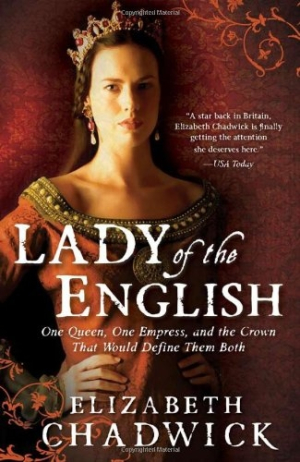Lady of the English
Lady of the English could just as well have been titled Ladies of the English: it centers on two quite different twelfth-century queens. The bond between these women is the thread that weaves balanced elements of history and romance into a story that reflects its setting and illuminates the continuing struggle of women to be accepted as powerful and feminine.
Mathilda, the lady of the title, is the only living heir of King Henry I. Feisty and contentious, she schemes to maintain her independence when her father arranges her marriage to Geoffrey of Anjou, an ambitious count half her age. Living in a man’s world, Mathilda fights to establish her claim to the English throne, setting the groundwork for the ascension of her son, Henry II.
Adeliza, Henry’s young second wife, embraces the traditional role of a queen—wife, mother, and peacemaker. Within these limits, she influences the kingdom’s destiny through her relationships with Henry and Mathilda and then with her second husband, William D’Albini.
Lady of the English is as much romance as history. Mathilda’s stormy relationship with Geoffrey contrasts with her sustaining bond to Brian FitzCount. After Henry’s death, Adeliza finds fulfillment with William D’Albini. He and Brian present a study of the ideal courtly lover and knight with a dose of conscience. Each struggles to reconcile his service to country with adherence to his ideals.
The characters and events are historically accurate. Chronicles of the English civil war of the twelfth century and later histories supplied the daring escapes and political intrigues that ground Chadwick’s imaginative extrapolations. As a member of the reenactment society Regia Anglorum, the author strives to accurately portray the Middle Ages. In this novel, she includes sufficient details of daily life and war to give her story texture. She also creates a sense of the influence of the Roman Catholic Church and religion in shaping private lives and international events. These elements should satisfy the reader interested in history as much as one reading for escape.
The book covers twenty-four years, enough material for two books. In the past Chadwick has devoted more than one of her twenty novels to related characters and events. Readers would certainly welcome other works centered on the vibrant characters presented here.
Reviewed by
Geraldine A. Richards
Disclosure: This article is not an endorsement, but a review. The publisher of this book provided free copies of the book to have their book reviewed by a professional reviewer. No fee was paid by the publisher for this review. Foreword Reviews only recommends books that we love. Foreword Magazine, Inc. is disclosing this in accordance with the Federal Trade Commission’s 16 CFR, Part 255.

